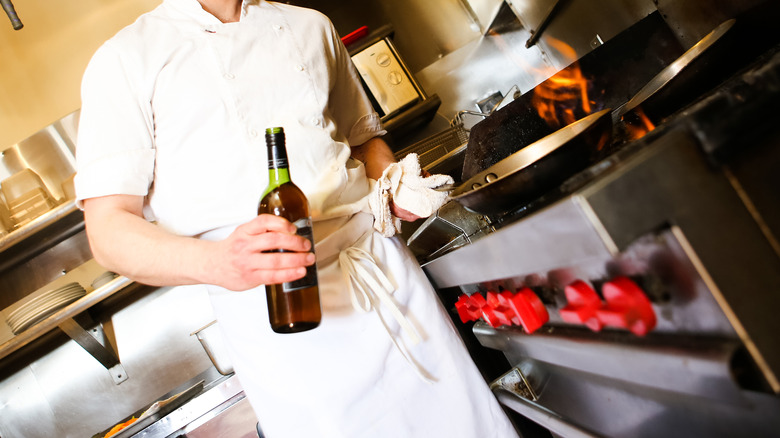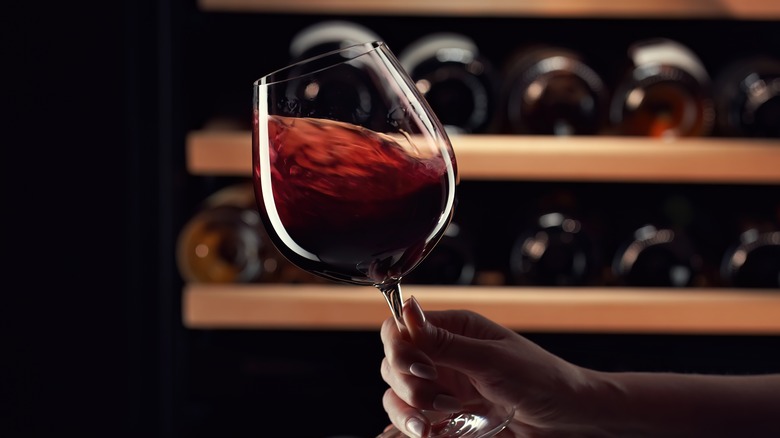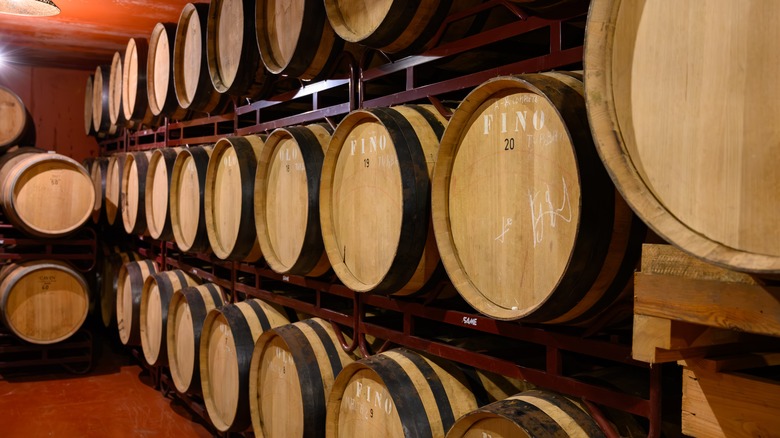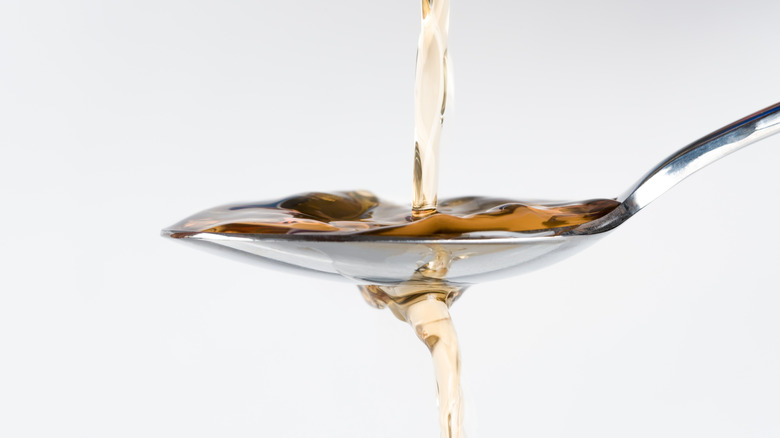The Important Differences Between Cooking With Wine Vs Sherry
It's a common occurrence: You begin assembling the ingredients for a recipe, say boeuf bourguignon, and you hubristically think to yourself, "There's a bottle of red wine in the rack that I can use." You get underway, searing the meat and sauteing the vegetables, and you head off to retrieve that wine only to discover ... it's actually a dusty bottle of sherry left over from an attempt at lobster Newburg years back. But, can it work in your boeuf bourguignon? What even is sherry?
To address this hyper-specific scenario: No, you can't replace the all-important wine — specifically, burgundy — in boeuf bourguignon with sherry. Yet, the Venn diagram of sherry and wine has much overlap and deserves to be explored in more detail. Wine is, of course, wine, and sherry is also wine but a different kind of wine that is used in very tailored ways in the kitchen to produce a bounty of flavors quite apart from regular red or white wines.
What is wine?
You may not understand how barley becomes beer or rye turns into whiskey, but wine is so straightforward that it's hard not to understand what it is. Grapes are a fruit with plenty of sugar. Yeast likes to eat sugar and excrete alcohol. Grapes get mashed and juiced, and yeast is introduced by design or spontaneously. Before you know it, you've got wine. While that's a touch of oversimplification that will probably rub vintners the wrong way, that's the gist of the process for making wine, aging aside.
In the broadest sense, you'll note flavors that are fruity, a bit sweet, floral, and tannic when tasting wine (and be sure to avoid these wine-tasting mistakes). Going more granular into the red, white, orange, rosé, and green varietals that abound, wine can be boldly structured, light and ephemeral, smoky, mineral-forward, bitter, sour, syrupy, and so on. These elements are a reflection of a great many factors, from the grapes used, the terroir that supports them, the contact they see with the grape skin, the aging process, blending, and even freezing on the vines. It can seem as if there is a wine for every occasion, and there might well be.
What is sherry?
Yes, sherry is wine, but it is a fortified wine. That's a term you may have heard of but are unfamiliar with, which is excusable as it has an antiquated history. Fortifying wine is an ancient form of preservation. Wine alone can quickly spoil and turn into vinegar if not stored under very specific parameters and in the right vessels. To combat spoilage, ingenious winemakers began to add high-proof spirits. Probably the best known among the fortified wines is vermouth, which is produced in a range of countries, like France and Italy.
Sherry is a bit more specific, though. While it can be made in other countries, sherry is predominantly associated with Spain, particularly the city of Jerez de la Frontera in Andalusia, a region overflowing with incredible foods that pair smashingly with sherry. White grape varietals palomino, Pedro Ximénez, and moscatel are fermented to create the base wine to which a neutral spirit is added, raising the alcohol level considerably above that of most standard wines. Sherry is no monolith, though, as it comes in a range of styles, from the dry, herbal Manzanilla to the sweeter, nuttier oloroso. The variations are born of different production styles that hinge on the oxidation of the wines. Further, sherry is aged in a unique style that promotes consistency among the various vintages.
Wine is fruit-forward
Wine is clearly used in cooking quite a bit. From the aforementioned ruddy and deeply-flavored boeuf bourguignon to a simple white wine pan sauce, traditional wines bring an array of flavors and acid that balance the richness of meats and the thickness of starchy vegetables. Dark berries, tobacco, and woody notes can be brought to bear with the judicious use of red wine, while white wines add brightness and notes of summer fruits. As the wine reduces, the alcohol cooks out, defanging the wine to a degree. At the same time, depending on how much reduction the cook allows, the wine is concentrating and even developing flavors that may not have been present or obvious in the wine's "raw" state.
Wine, as with other spirits, pulls double duty. In addition to bringing its incumbent flavors to the dish at hand, the alcohol itself unlocks flavors in certain ingredients that would otherwise remain insoluble. Tomatoes, for instance, benefit greatly from the presence of alcohol, which is one of the reasons you often see the two ingredients used in conjunction.
Sherry has a more assertive bite
Be it sweet or dry, do not swap out wine for sherry in a recipe. Just as you would not, as a matter of practice, replace a red wine with a white, sherry is not a one-to-one substitute for its non-fortified cousins. The reason is that sherry just tastes remarkably different from white and red wines. Yes, sherry and wine can have certain overlapping flavors, but they are too different to use as stand-ins for one another. Don't just take our word for it; consider purchasing a small bottle of fino sherry, oloroso, or both and sip to see the flavors that come through. If you're even slightly experienced in the kitchen, you'll be able to see the stark differences.
When sherry is deployed in culinary settings, note that it is often in quantities much smaller than when wine is used. That's due to a couple of reasons. One is that sherry, both sweet and dry, is more intensely flavored than regular wine. In large quantities, it would dominate a dish, blotting out the subtle flavors it is meant to enhance. Second, the higher ABV of sherry means that it has a much more pronounced alcohol bite that is not as easy to burn off. That said, sherry adds a wonderful touch to a number of dishes, such as luxurious, creamy lobster Newburg, or as a finishing touch to Philadelphia's famous Bookbinder soup.




